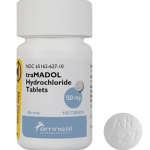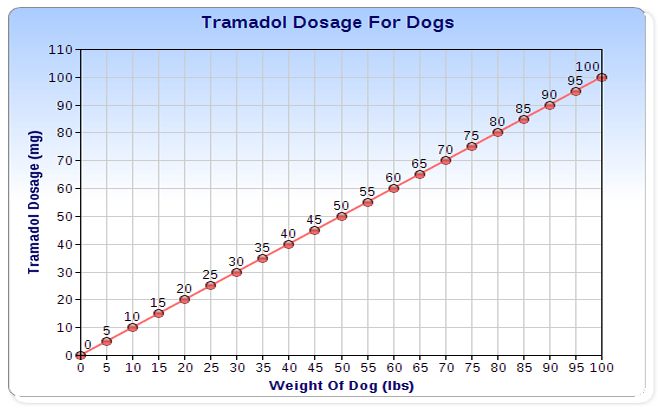Pain meds for dogs

Dogs feel pain when they are injured, sick or simply age. Pet parents sometimes find it difficult to recognize pain in their dogs, simply because dogs do not act in the same way that humans do when in pain.
Selecting the most suitable drug or drug combination for your dog will be based on how much pain your dog is in, and his overall health. Reducing your dog’s stress, anxiety, pain level, and providing good care will maximize your veterinarian’s treatment regimen.
Pain will interfere with every part of your dog’s life! It is important to visit your veterinarian if your dog shows signs of pain or illness. Acute surgical, traumatic, and disease related pain in dogs is treated with one or more analgesic, or pain relieving drugs like Tramadol.
What is Tramadol used for?

Tramadol is widely used by veterinarians to manage mild to moderate pain in dogs suffering from various painful conditions. Tramadol alters the transmission and perception of pain in dogs. As a result, it inhibits the re-uptake of norepinephrine and serotonin, and increases the level of these chemicals in the dog’s bloodstream.
It is a centrally acting opioid analgesic used for things like:
- treatment of postoperative conditions
- nonsurgical intervertebral disc disease
- lameness
- general pain from an injury or another condition
- cancer
- or chronic neuropathic pain.
Tramadol is a synthetic opioid similar to morphine, that is categorized as a scheduled IV controlled substance by the DEA.The DEA classified tramadol as an opioid because of the agency’s findings that Tramadol’s pharmacological effects are similar to those of other opioids.
The only way to get it is with a prescription from your veterinarian. Human Tramadol should not be given to pets since dosage differs vastly, and the incorrect dosage could lead to an overdose. Pet parents should only use Tramadol under the guidance of a veterinarian.
Tramadol may help dogs with these conditions

Canine cancer pain
The Merck Veterinary Manual suggests using Tramadol to treat both acute and chronic pain. Both acute and chronic pain fall within the range of moderate to severe on the pain scale. Cancer pain is unique and difficult to treat because there are numerous causes of cancer pain, such as:
- tumorigenic (tumor-related products)
- inflammatory
- and neuropathic.
Similar to other forms of chronic pain, cancer pain does not always respond successfully to treatments commonly used.
However, opioids remain a good basis of treatment. They are used in conjunction with other treatments. These include analgesics like NSAIDs, tramadol, acetaminophen and amantadine which alleviates chronic pain. An opioid and an NSAID are commonly used together because of their stronger action in eliminating cancer pain when combined.
That said, like most chronic pain, cancer pain management needs to be looked at regularly, and pain management updated together with the correct therapeutic changes.
Osteoarthritis pain (degenerative joint disease)
Joint degeneration is the result of trauma, infection, the body’s own immune system or malformation during development. That said, when this results in the inflammation of the joint membrane, continued cartilage destruction and inflammation, and abnormal joint function, dogs feel intense bone pain.
This condition is characterized by:
- thinning of the cartilage
- build -up of fluid within the joint
- and the formation of bony outgrowths around the joint.
Signs of osteoarthritis may include:
- lameness
- swelling of the joint
- muscle wasting
- thickening and scarring of the tissue joint membrane.
Progressive damage occurs inside the dog resulting in:
- grating sound during joint movement
- soft-tissue swelling around the joint
- formation of bony outgrowths
- hardening and thickening of bone beneath the cartilage
- and possibly a narrowed joint space.
Related: Best Glucosamine for Dogs – Hip & Joint Dog Supplements
Veterinarians may include the use of Tramadol to block the transmission of pain signals in the dog. New research out of the University of Georgia, when evaluating Tramadol as an analgesic in the treatment of chronic osteoarthritis found that Tramadol did not improve pain scores when used for treating canine osteoarthritis compared to Carprofen.
The research concluded that “Tramadol is not an effective analgesic as it does not provide improvement in pain for dogs suffering from elbow or stifle osteoarthritis.” The research further surmised that it is unlikely to help with osteoarthritic pain and dysfunction in other joints.
Nonsurgical intervertebral disc disease (IVDD)
This condition is a degenerative disease of the spinal column that results in compression of the spinal cord and spinal nerves. It is a common cause of spinal cord disorders in dogs, most especially in smaller breeds resulting in slipped disks.
This can occur as early on as 1-2 years of age. With larger dog breeds, slipped disks tend to occur after age 5. Herniated disks occur mostly in the neck and middle of the back resulting in severe pain, stiffness, and muscle spasms. Neurologic signs include loss of motor control in the hind legs to paralysis and incontinence.
Diagnosis of the herniated disks by a veterinarian requires:
- X-rays
- myelography
- computed tomography(CT)
- or magnetic resonance imaging (MRI).
Veterinarians will prescribe steroids, anti-inflammatories(NSAIDS) and pain medications. Tramadol is often prescribed to help with the severe pain associated with IVDD. It binds to and blocks receptors in the brain (opioid receptors) that are important for transmitting the sensation of pain throughout the dog’s body.
Post-operative pain
Postoperative pain control is an important aspect for surgical veterinary care in dogs. Sufficient pain relief after surgery or trauma allows the dog to rest. Dogs will sleep longer for a few days after any surgery, yet they should be easily awoken if the dosage of the analgesic drug is appropriate.
In addition to the many drug types that are available for postoperative analgesia such as opioids and non-steroidal antiinflammatories, Tramadol, a synthetic opioid, is a widely used analgesic. As with any pain-relief medication, the dosage needs to be decreased gradually, and not stopped suddenly.
General pain
Signs of chronic pain in dogs are less obvious, and harder to recognize than signs of traumatic or surgical pain. Veterinarians observe signs of chronic pain by using a pain scale. This is a questionnaire that includes such things as the:
- dog’s age
- gender
- environmental conditions
- cause of pain
- region of the body that is affected
- as well as the intensity and duration of the pain.
Pain severity is hard to calculate, as well as how the individual dog is coping. Veterinarians will prescribe Tramadol to relieve pain. While sedation is a common side effect of Tramadol, it helps dogs that are suffering from pain to relax. The effect of the opioid will depend on the dose, the health of the dog, as well as the administration of other drugs at the same time.
Veterinarians may treat general pain with a combination of analgesic drugs, of which each drug is given in a smaller dose to provide adequate pain relief.
Tramadol is also used to treat the following conditions:
- Canine cough
- Lameness
- Canine degenerative myelopathy
Related: Best Dog DNA Tests – Discover Your Dogs Genetics
Benefits of Tramadol for dogs

There are a good amount of reasons that veterinarians prescribe Tramadol for dogs. Apart from relieving acute and chronic pain, it can also be used in conjunction with other medications.
“Tramadol’s popularity as an oral analgesic in veterinary medicine stems from a relatively low incidence of gastrointestinal and cardiovascular side effects with chronic use,” explains Dr. Sandra Perkowski, VMD, PhD, DACVA, University of Pennsylvania School of Veterinary Medicine, Philadelphia.
Among the benefits of giving Tramadol to dogs are:
- pain reliever
- relaxes dogs in pain
- allows for dogs suffering from canine osteoarthritis to have greater mobility
- promotes rest in dogs recovering from surgery
- allows for faster recovery time
Side effects of Tramadol in dogs

Opioids relieve pain by acting on the central nervous system. Continuous administration of pain medication is more effective at relieving pain than by using “as-needed” dosing. That said,
Tramadol may have a few side effects as well, such as:
- Constipation
- Diarrhea
- Dizziness
- Drowsiness
- Tremors
- Nausea
- Loss of Appetite
- Sedation
- Anxiety
- Pupil Constriction
- Coughing
- Seizures
- Decreased heart rate
- Agitation
- Peeling skin rash
- Blisters on skin
Here’s what Dr. Salisu Buhari, DVM of the The Scientific World Journal, has to say about it:
“Although Tramadol has a rapid onset of effect when given to dogs IV or intramuscularly, it can also produce unwanted side effects such as nausea, salivation, increased swallowing, and retching. Another effective analgesic strategy, epidural analgesia, carries the risk of nerve injury and side effects that include pruritus, urinary retention, hypoventilation and hypotension.
In contrast, better patient compliance with minimal restraint was achieved in the SC group. In this study, none of the dogs suffered from adverse effects of tramadol, regardless of the route of administration.
According to Hendrix et al., marked respiratory depression is not observed in dogs, even with morphine administration. In addition, although vomiting is reported to occur within 5–10 min of SC administration of morphine, this effect is not reported with other opioids.”
Sedation is a common side effect. Though, this is not a major problem for veterinarians or pet parents who would rather have their pets asleep, not feeling any pain. Rest also promotes faster healing and tissue regeneration.
Adverse reactions to Tramadol in dogs
Adverse reactions to Tramadol may include:
- swelling of the tongue and throat
- breathing problems
- and skin lesions.
“Most adverse effects in humans are related to gastrointestinal side effects including nausea and vomiting. One study looking at the mortality in human patients hospitalized for perforated peptic ulcers, found that Tramadol increased mortality at a level comparable to NSAID’s”, explains Dr. Sandra Perkowski, VMD, PhD, DACVA, from the University of Pennsylvania’s School of Veterinary Medicine in Philadelphia.
Facts about Tramadol

Tramadol is a centrally acting analgesic used for pain relief in pets and people. According to various studies, Tramadol is not effective alone, and needs to be used together with anti-inflammatories, and other analgesics for any acute or chronic pain.
Giorgi et al (2009) found that Tramadol was rapidly absorbed after oral administration of an immediate release capsule (4 mg/kg), but was rapidly metabolized to two other main metabolites the M5 and M2 metabolite, rather than the M1 metabolite.
KuKanich and Papich (2011) also found that M1 to be a minor metabolite after a dose of 10 mg/kg Tramadol in Greyhounds. The study found that the half-lives of both Tramadol and all three metabolites were short. (Tramadol: 1.1 hr. vs M1:M2) Research also found that differences in pharmacologic formulations can hugely effect both the bioavailability and the pattern of metabolites formed.
The study indicates that Tramadol administered orally in dogs as an immediate release tablet is 65% bioavailable with a short half-life of 1.5-2 hours. The sustained release formulation and rectal suppository yielded only a 10% bioavailability.
Today questions are still being asked about Tramadol’s efficacy and appropriate dosing intervals. Although Tramadol has become immensely popular among veterinarians, there is still more research that needs to be done. Tramadol was initially formulated for people. Some dogs on other medications may need to avoid taking Tramadol in case of a drug interaction.
Note: Pregnant female dogs should also avoid taking Tramadol since this drug will affect the puppies.
Things to ask your veterinarian

Before prescribing Tramadol your veterinarian will most likely begin discussing treatment options. He or she will recommend and advise you about the specific disorder, and the recommended drugs that will be needed to treat the disorder.
You will need to thoroughly discuss with your veterinarian any medications, prescriptions, over-the-counter, or herbal that you are giving your dog. You will also need to inform yourself about how Tramadol works, and any possible side effects that this drug may have on your dog.
Most importantly, you will need to prepare yourself in advance should there be any side effects that would need immediate emergency veterinary care. Even if Tramadol seems easy enough to use, or you’ve given this to your dog in the past, it’s still important to follow all instructions carefully. Correct dosages must be administered at all times.
Inform your veterinarian if your dog suffers from seizures. Tramadol cannot be given to dogs with a seizure history. Gastrointestinal problems, pregnancy, liver disorders and kidney disease are among the range of conditions or diseases that will prevent your veterinarian from prescribing Tramadol.
Tramadol dosage for dogs

Tramadol has been developed to provide your dog with pain relief. Sometimes giving medications to dogs can be complicated and difficult. Tramadol also has not been approved for use in dogs, only humans. Many drugs like Tramadol used in dogs in the U.S have not been formally approved by the Food and Drug Administration, (FDA) for use in certain animals.
Veterinarians have the legal right to prescribe drugs like Tramadol for purposes beyond those for which they have been approved. That said, how do I give my dog Tramadol?
. . . it is recommended that dogs be given Tramadol at 0.45 to 1.8 mg per pound of the dog’s body weight. The recommended frequency is every 8-12 hours.
Nonetheless, if it is cancerous pain or pain that is the result of a tumor, pain relief from Tramadol should be every 6 hours. Lots of water should be provided to dogs that are on Tramadol.
What to do about missing doses?

Never double up on a missed dose of Tramadol**!** Should you miss the one dose, administer it if there are a couple of hours in between it and the next dose. That said, veterinarians recommend waiting until the next succeeding dose to be given to the dog as scheduled; if the gap between succeeding doses is too short.
Pro tip: Consult with your veterinarian to confirm dosing schedules for Tramadol.
Tramadol overdose in dogs

Tramadol is a synthetic opiate that is a derivative of codeine. It is widely used in veterinary medicine as a pain reliever. The main effects of opioids are on the central nervous system, and on the cardiovascular, respiratory, and gastrointestinal systems. That being said, Tramadol overdoses can occur.
Common signs of Tramadol overdoses or poisonings include:
- central nervous system depression
- drowsiness
- lack of coordination
- vomiting
- seizures
- small pupils
- coma
- depressed breathing
- low blood pressure
- constipation
- and in some cases even death.
Diagnosis of overdoses are made based on the history of exposure and the signs. Urine will also be analyzed. Overdoses of Tramadol can be reversed with naxalone. This will need to be repeated because the duration of action may be less than the amount of opioid being reversed.
Dogs need to be closely monitored for depressed breathing, and will be put on a ventilator of needed. The importance of following the correct dosage schedules is crucial and cannot be over emphasized.
Drug interaction with Tramadol
There are certain drugs that may interact with Tramadol. These include:
- antidepressants
- monoamine oxidase inhibitors
- warfarin
- ketoconazole
- digoxin
- any other medication that may have an adverse effect when combined with Tramadol.
- herbal products need to be approved by a veterinarian prior to using Tramadol.
- nutritional supplements also will need to be approved by a veterinarian.
- OTC medications.
Tramadol is used for pain control, and is a controlled scheduled IV analgesic which still requires a narcotic type prescription. It is also a relatively low cost drug. While there have been no studies demonstrating dependence in dogs, Tramadol needs to be gradually decreased to help avoid withdrawal symptoms.
Final thoughts on Tramadol
Taking a little more time to talk to your veterinarian prior to the use of Tramadol in your pets will allow you to discuss the adverse side effects should they occur. Additionally, it allows you to discuss the pros and cons of Tramadol use.
While Tramadol is relatively safe and benign, more so than morphine and codeine, veterinarians have to use anti-inflammatories and other analgesics to treat acute and chronic pain.
There are still questions regarding appropriate dose and dosing intervals for Tramadol. As a pet parent you will need to thoroughly inform yourself as to how Tramadol works, and any negative effects it may have on your dog. Keep in mind that minimizing stress and pain has to be top priority! Tramadol treats pain in dogs, and will greatly improve his quality of life.
